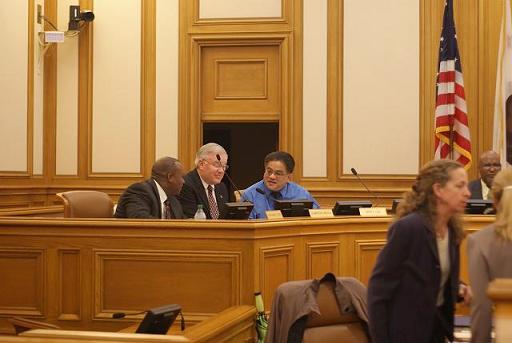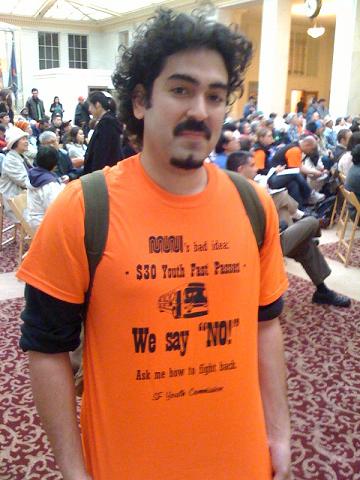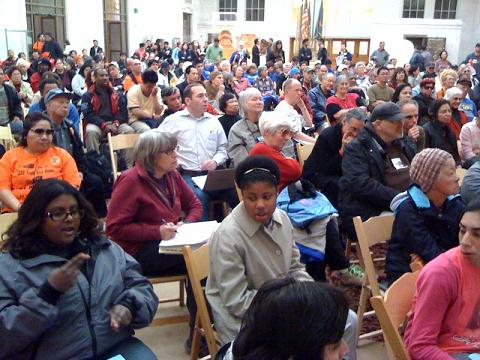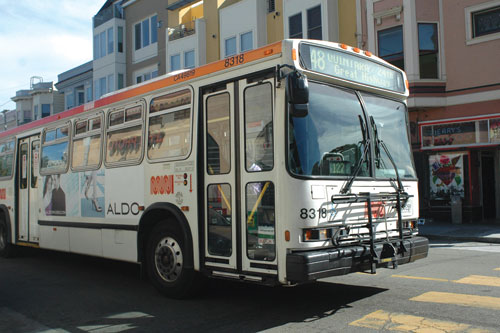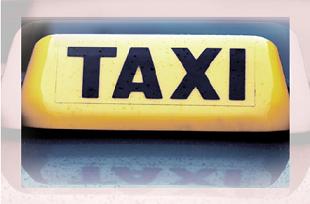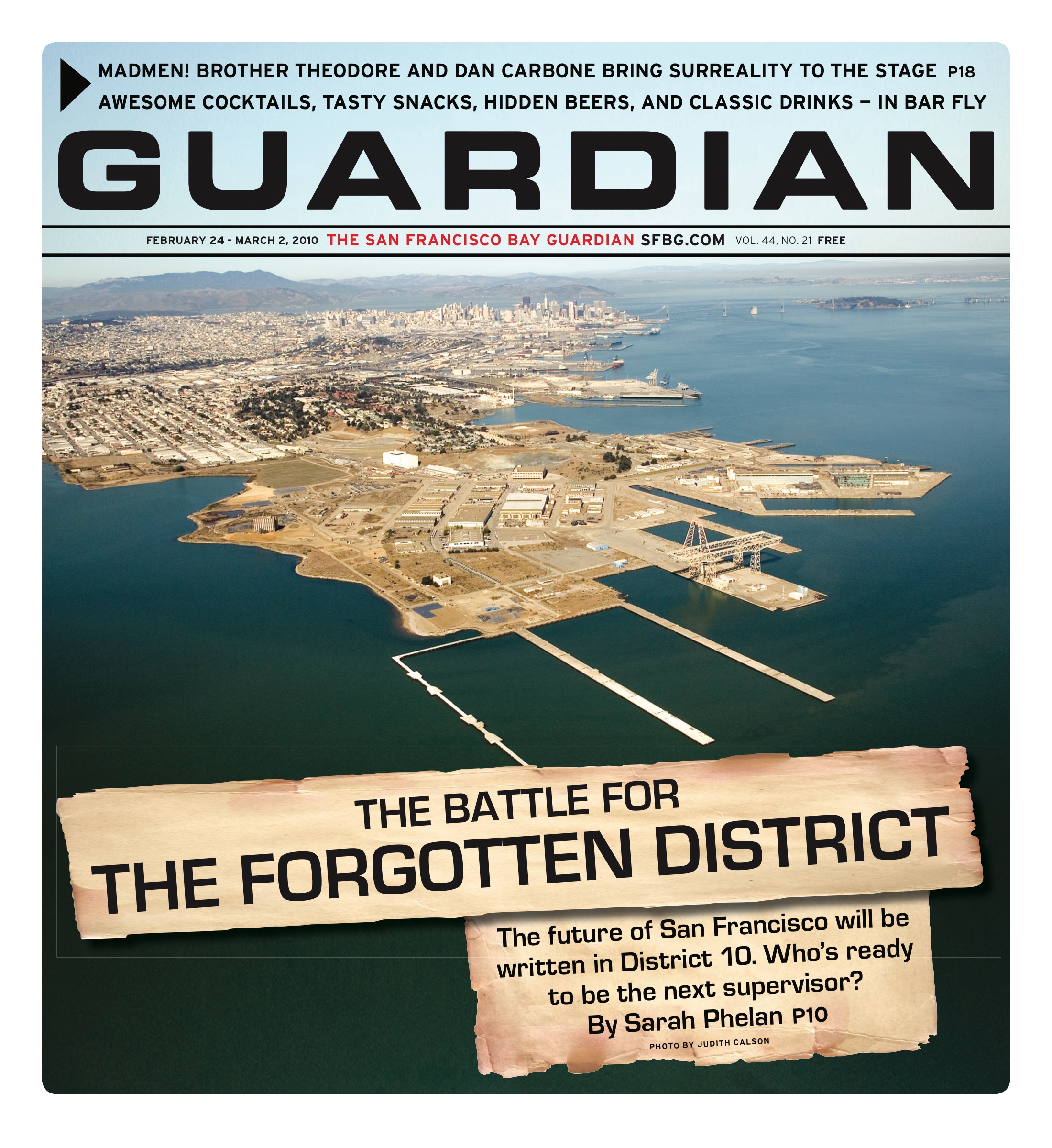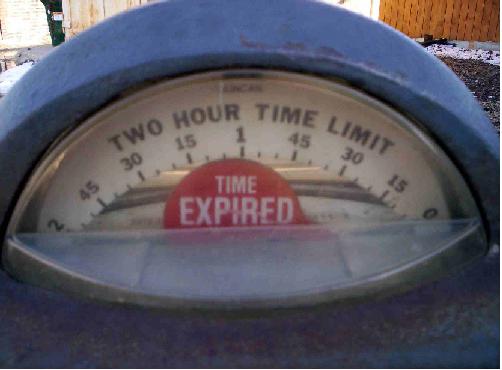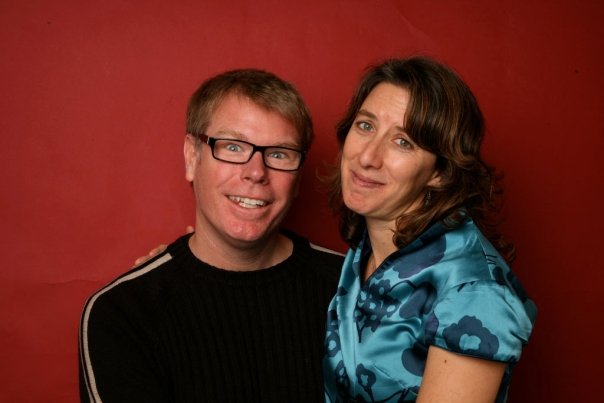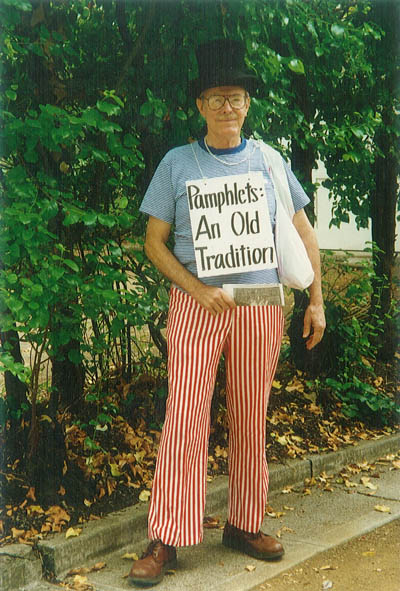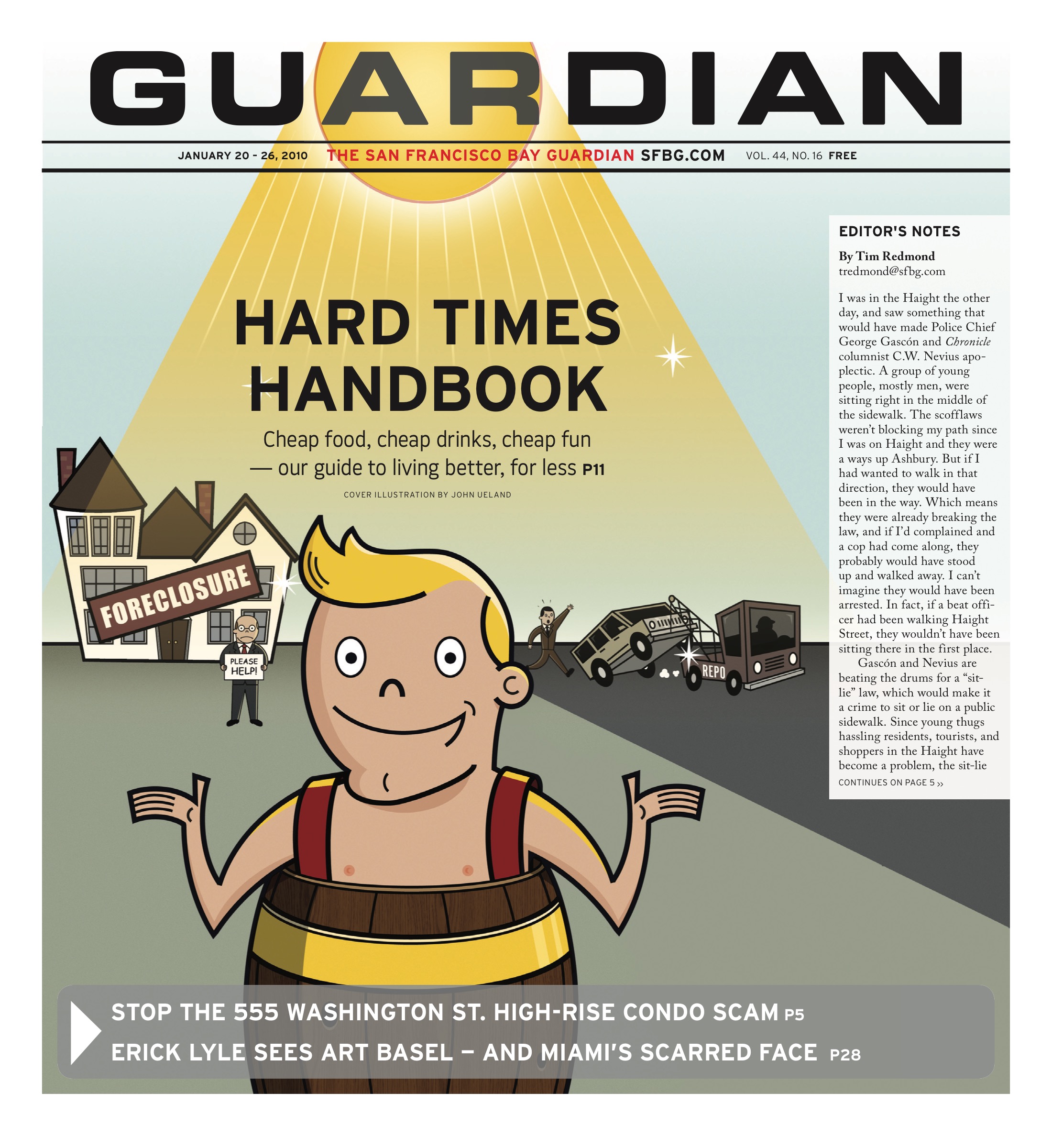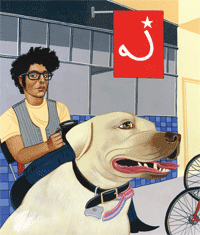BEST LOCAL BLOG
N Judah Chronicles
Crazies, crashes, coins! Public transportation is way more exciting than the freeway. Share your tales of Muni woe (and whoa!) with blogger Greg Dewar.
www.njudahchronicles.com
BEST LOCAL WEB SITE
BeyondChron.org
Politics, current events, and culture coverage for people smart enough to distrust “the Voice of the West.” BeyondChron.org is the FUBU of local news sources.
www.beyondchron.com
BEST TATTOO ARTIST
Freddy Corbin, Temple Tattoo
Corbin’s work can be found on the arms and necks of hipsters from here to China. Intricate, original, and flawless. In a word: gangsta.
384 17th St., Oakl. (510) 451-6423, www.templeoakland.com
BEST TATTOO SHOP
Black and Blue
The renowned female artists at B&B may not be able to pee while standing (we think), but they’ll man up to the needles any day. The best tattoos in town.
381 Guerrero, SF. (415) 626-0770, www.blackandbluetattoo.com
BEST POLITICIAN YOU LOVE TO HATE
Gavin Newsom
Is it his creepy smile, his perfect hair, or his questionable policies and personal life that irritates everyone so much? Whatever it is, the dude fucking sucks.
BEST POLITICIAN
Gavin Newsom
Er, time out. Newsom’s not that bad. He’s kind of sexy in a Zoolander sort of way, and he did stand up for gay marriage. Plus, he’s related to Joanna. Thumbs up, dude. You win.
BEST LOCAL NONPROFIT
Homeless Prenatal Program
Being homeless sucks, but homeless and pregnant? Come on! Luckily, HPP has been assisting homeless mothers-to-be with their situation since 1998.
2500 18th St., SF. (415) 546-6756, www.homelessprenatal.org
BEST EMERGING ARTIST
Nanci Price Scoular
Scoular’s abstract painting style is like an onion, revealing layer after layer of the artist’s struggle to belong.
www.pricescoular.com
BEST ART COLLECTIVE
Liberation Ink
Liberation Ink designs T-shirts and accessories for liberal arts majors, cute activists, and hippies with fashion sense. All profits support local grassroots organizations.
(415) 294-3196, www.liberationink.org
BEST TOURIST SPOT LOCALS SHOULD VISIT
Alcatraz
Wading through hordes of blissfully ignorant, clam-chowder-chomping tourists is never much fun, but sometimes the destination is worth it. Alcatraz is such a place — the best, in fact.
www.nps.gov/alcatraz
BEST LOCAL AUTHOR
Broke-Ass Stuart
Stuart’s city guidebooks may fly off the shelves these days, but the dude’s still broke as shit. It doesn’t stop him from having fun, though, and it shouldn’t stop you either.
www.brokeassstuart.com
BEST LOCAL ZINE (PRINT)
The Loin’s Mouth
Read about the ups and tragic downs (plus anonymous sexcapades!) of Tenderloin dwellers every month in The Loin’s Mouth.
www.theloinsmouth.com
BEST LOCAL ZINE (WEB)
Big Top Magazine
Circus freaks, sideshow performers, exhibitionists, and straight-up weirdos. Big Top Magazine gives a voice to them all. Finally!
www.bigtopmagazine.com
BEST LOCAL RECORD LABEL
Six Degrees
Dedicated to the sweet and sexy sounds of international genre-bending, Six Degrees offers the best in contemporary music from across the globe.
www.sixdegreesrecords.com
BEST LOCAL PUBLISHING HOUSE
McSweeney’s
Like books? Pirates? Clever writing with a socially conscious twist? Dave Eggers and McSweeney’s wants you!
www.mcsweeneys.net
BEST TV NEWSCASTER
Dennis Richmond
In a perfect world, all news anchors would be like newly retired Richmond: cool, composed, and confident enough to rock the same mustache through decades of facial hair trends.
www.ktvu.com
BEST LOCALLY PRODUCED TV SHOW
Check, Please! Bay Area
Regular Bay Area residents review San Francisco’s finest restaurants. No pretense, no expertise, no bullshit. Genius!
www.blogs.kqed.org/food
BEST RADIO STATION
Energy 92.7 FM
Indie rock’s cool and all, but sometimes you just wanna bump Rihanna, Britney Spears, or Gunther. Cut a rug at Energy 92.7, the ass-movingest radio station in the Bay.
www.energy927fm.com
BEST STREET FAIR
Folsom Street Fair
More cock than a chicken fight! More ass than a donkey show! Break out those chaps and grab some lube when the sprawling granddaddy of leather events hits in September.
www.folsomstreetfair.org
BEST DOG-WALKING SERVICE
Mighty Dog
Most dog walkers stop after a stroll, but Mighty will take Fido to the beach, give him a trim, and maybe even introduce him to some hot tail.
1536 Alabama, SF. (415) 235-5151, www.mightydogwalking.com
BEST PET GROOMER
 Little Ark
Little Ark
Grooming Shop: Best Pet Groomer
GUARDIAN PHOTO BY CHARLES RUSSOLittle Ark Grooming Shop
Dogs make nice child substitutes, but they can get dirty as hell. Clean ’em up at Little Ark, the best groom shop in town.
748 14th St., SF. (415) 626-7574
BEST VETERINARIAN
Pets Unlimited
Sick pets suck. They whine all day, smell nasty, and repel potential lovers. Get them fixed up at Pets Unlimited.
2343 Fillmore, SF. (415) 563-6700, www.petsunlimited.org
BEST CAMP FOR KIDS
Camp Galileo
Art, science, and outdoor activities for students from prekindergarten to entering fifth grade. Summer camp for creative types.
(415) 595-7293, www.campgalileo.com
BEST DENTIST
Dr. Natasha Lee, Better Living Through Dentistry
Drugs and alcohol will do the trick temporarily, but if you really want a better life, fix your grill at Dr. Lee’s.
1317 Ninth Ave., SF. (415) 731-9311
BEST DOCTOR
Dr. Scott Swanson, Parkside Chiropractic
Need a backiotomy? Head to Parkside Chiropractic, where Dr. Swanson will snap your spine back into action.
2394 31st Ave., SF. (415) 566-7134, www.parksidechiro.com
BEST MASSAGE THERAPIST
Joshua Alexander, CMT
He will listen to your body and honor what he hears with a plethora of techniques, including energy work modalities ranging from Swedish and deep tissue to shiatsu and polarity.
Castro and Market, SF. (415) 225-3460, www.joshuaalexandercmt.com
BEST MECHANIC
Pat’s Garage
Cars may never be as environmentally friendly as bicycles, but they get substantially closer at Pat’s, San Francisco’s premier green auto shop. Plus, organic coffee!
1090 26th St., SF. (415) 647-4500, www.patsgarage.com
BEST PLACE FOR A HAIRCUT
Dekko Salon
If you’re looking for a truly individualized experience, get your hair styled at swanky Dekko, San Francisco’s most luxurious hair and art gallery.
1325 Indiana, SF. (415) 285-8848, www.dekkosalon.com
BEST DAY SPA
Blue Turtle Spa
Cruelty-free skin products and beauty services for your worldly vessel. Animals shouldn’t have to suffer just so you can look pretty.
57 West Portal, SF. (415) 699-8494, www.blueturtlespa.com
BEST SHOE REPAIR
Anthony’s Shoe Repair
There’s nothing worse than showing up to a party in a scuffed-up pair of kicks. Anthony will restitch, resole, and stretch your shoes back to freshness.
30 Geary, SF. (415) 781-1338
BEST TAILOR
Cable Car Tailors
Throw your thrift store finds in a bag with some oversize slacks and wait for CC Tailors to work their magic.
200 O’Farrell, SF. (415) 781-4636
BEST ROOMMATE REFERRAL SERVICE
Craigslist
Where else can you find someone actively seeking a “sex-positive, 420-friendly, artsy-fartsy new housemate who likes cats and cooks vegan”?
www.craigslist.com
BEST LOCAL ANIMAL RESCUE
San Francisco SPCA
Rescuing distressed pooches and wayward felines since 1868, this SPCA outpost offers a stunning array of humane services.
2500 16th St., SF. (415) 554-3000, www.sfspca.org
BEST LAUNDROMAT
Brainwash
Drink beer, eat food, and wash duds with stand-up comedians, SoMa punks, live bands, and swingers from nearby One Taste Urban Retreat Center.
1122 Folsom, SF. (415) 861-3663, www.brainwash.com
BEST BICYCLE MECHANIC
Bike Kitchen
Give a man a bike; he’ll ride until it breaks. Give him the tools to fix a bike (the Bike Kitchen’s raison d’être); he’ll ride for life.
1256 Mission, SF. (415) 255-2453, www.bikekitchen.org
City Living
BEST PIRATES ON THE DIAL
We love the independents, and it doesn’t get much more independent than pirate radio. West Add Radio, on 93.7 FM, features some of the most adventurous musical programming in the city — from minimal techno crew Kontrol and Green Gorilla Lounge’s M3 to Cobain in a Coma, a show about music, celebrity gossip, and homo drug culture with a cult following, and Pancake Radio, with prolific DJ Ryan Poulsen. The advantage to flying under FCC radar? Anything goes — the seven dirty words, explicit lyrics, inappropriate banter, obscure kraut rock — if you’re lucky enough to pick up the signal. Otherwise, you can access the live stream and podcast archive online. (Hurray for the Internet.) In addition to its radio programming, West Add has become known for its parties, most significantly the monthly Italo-disco Ferrari at Deco Lounge, but also quirky nights such as “Merry Crass-mas,” a tribute to CRASS. West Add has also started releasing the free zine WAR in collaboration with Aquarius Records. Radio’s not dead!
www.westaddradio.com
BEST DRIVEWAY OF DESTINY
Driving in these eco-conscious times may be unfortunate, but since 2002, when artists Harrell Fletcher and Jon Rubin stenciled fortunes into each of its parking spaces, the North Beach Parking Garage has offered a curious kind of hope. Some fortunes are cookie classics (“Opportunity is fleeting”). Others are enticingly bawdy (“There is a party inside you” abutting “Your lovers [plural] will never wish to leave you”). Some contain road rage management tips (“It is often better to not see insult than to avenge it”) or reality checks (“Your trouble is that you think you have time”). The best of ’em trigger intriguing dilemmas for the superstitious — do you cast a shadow over your day by parking in “A whisper separates friends”? Do you wait for “You are not a has-been” to become free? If you need to come up for air, hit the garage’s roof: its lovely view of Saints Peter and Paul Church and the Transamerica Pyramid (along with nearby Chinatown clotheslines) will wipe your mind clear of ontological philosophizing.
735 Vallejo, SF. (415) 399-9564
BEST AMAZING JOURNEY INWARD
 The Melvin M. Sweig Interfaith
The Melvin M. Sweig Interfaith
Memorial Labyrinth: Best Amazing Journey Inward
GUARDIAN PHOTO BY CHARLES RUSSOThe ancient mystical tradition of the labyrinth lives on in front of Grace Cathedral with the ostentatiously named Melvin M. Swig Interfaith Memorial Labyrinth. Laid out in terrazzo in the meditation garden to the left of the cathedral entrance is a replica of the medieval 11-circuit labyrinth on the floor of Chartres Cathedral. A labyrinth is not a maze; there is but one path, and it leads to the center. Yet as with so many other things in life (childhood, religion, partying), the point is the journey. The walk through the labyrinth is surprisingly long and circuitous, one well suited to embodying your preferred metaphor. It’s difficult not to be contemplative as you slowly wend your way through the three stages of the labyrinth: purgation (the walk in), illumination (standing at the center), and finally, union (walking out). You may not have achieved perfect spiritual balance by the time you exit, but you can’t help feeling slightly more enlightened.
1100 California, SF. (415) 749-6300, www.gracecathedral.com
BEST MICROWAVE TOSS
Most people just throw their broken electronics in the trash. If your conscience won’t let you contribute to the 220 tons of e-waste dumped annually in the United States alone, consider hauling the dot matrix printer you’ve been guiltily hiding in the basement for the past 15 years to an electronics recycling service. Green Citizen boasts of its ability to recycle “anything with a plug.” CEO James Kao acknowledges that the actual output of reusable material is often small — consider alkaline batteries, which must be carefully broken down to get at a mere 3 mg of zinc. But the larger advantage is the safe disposal of the toxic substances within your cast-off gadgets, which can leach into the soil if left in landfills. Green Citizen even assigns a unique serial number to every item it recycles, so its various parts can be traced all the way to their final destinations. There’s a small fee for certain items, usually well under $10, but you’ll be a bit more free of guilt. Now about all that consumption …
591 Howard, SF. (415) 287-0000, www.greencitizen.com
BEST NO-NONSENSE KNOT REMOVAL
Forget the soothing new age music, bubbling indoor waterfalls, and arcane aromatherapy. Sometimes you’re broke, your back is full of knots, and all you want at the end of a rough week is a no-nonsense deep-tissue massage. At Jin Healing for Women a 60-minute full body will set you back $39 — or $30 if you buy a six-hour package. For that price, who cares if they don’t serve cucumber water or slather you in organic clay? The massage style falls somewhere between shiatsu and Swedish: the masseurs use oil, acupressure, and plenty of strength. The best part of the massage is arguably the hot towel treatment at the end. Some may complain that the place is too noisy — it’s not uncommon to hear the receptionist answering the phone or people talking outside — but it’s nothing that earplugs or an iPod can’t block out. While Jin Healing for Women is advertised as serving women only, some have found that men are not turned away if accompanied by a female friend or family member.
999 Powell, SF; 3557 Geary, SF. (415) 986-1111
BEST BUDGET SHRINKS
It’s not easy being blue — especially if you’re short on green and your health insurance doesn’t cover mental health services. Or if you don’t have health insurance at all. Luckily, the California Institute for Integral Studies offers “mind-body-spirit” counseling and psychotherapy on a sliding scale based on your income. The friendly CIIS therapists are graduate students and postgraduate interns working under the supervision of an instructor. With five counseling centers across the city, each with its own specialty, CIIS has expertise in a wide range of “therapeutic orientations,” including somatic, transpersonal, psychodynamic, and gestalt, as well as more conventional modes of psychotherapy. The holistic approach and alternative fee system make CIIS an ideal counseling center for a city like San Francisco.
www.ciis.edu/counseling
BEST BEATS KEEP BOPPIN’
North Beach has come a long way since the days when Lawrence Ferlinghetti et al. drank gallons of cheap red wine at Caffe Trieste. Though it’s now more frat boy than the best minds of a generation starving, hysterical, and naked, North Beach does sometimes remember its poetic beat heritage. For a weekend each May, Kerouac Alley — recently repaved with cobblestones and stone tablets engraved with quotes by Western and Chinese poets — is home to dozens of emerging and established artists showcasing their recent work in the open air for Art in the Alley. Live music, painting, poetry, and sculpture bring back the creative bohemian buzz that enveloped North Beach before the blonde beer haze did, and the art is always on display at fab sponsor Vesuvio bar for a couple of weeks before the festival. Perhaps best of all, at the end of the alley is surreal karaoke bar Bow Bow’s, where bartender Mama Candy serves a mean Tokyo Tea. After some heady art and a couple of those, you’ll be shouting lines from Howl yourself.
Kerouac Alley, between Columbus and Broadway, SF. www.vesuvio.com
BEST [EUPHEMISM] WAX
Women’s products and services are all about euphemism. Douche becomes a feminine cleansing product; a period becomes “celebrating one’s femininity.” And of course, the bikini wax, or Brazilian, is really a way to get hair off your cha-cha. Lonni of Lonni’s Punani dispenses with all niceties with the candid name of her Potrero Hill waxing service. Her motto? “Keeping San Francisco smooth one pussy at a time.” The name and motto may be blunt, even crass, but the end results will indeed leave a woman’s naughty bits smooth and ingrown-free. Lonni, a certified aesthetician and a pastry chef with a degree in sociology, forgoes mood lighting and new age music for bright environs, a rocking soundtrack, and fingers quick enough to make you forget she’s ripping hair off your most sensitive regions. (House calls are also offered.) And she doesn’t just stick to the punani: “manzilians” are happily performed as well.
1756 18th St., SF. (415) 215-7678, www.lonnispunani.com
BEST PUPIL PAINTER
Master artists don’t always work on canvas or paper. Steven R. Young, BCO, uses little plastic orbs as his canvases. And his work never appears in museums: you see it on people’s faces, and most of the time, he’s so good you never know it’s there. Young paints eyes — false eyes, replacements for people who have lost a real eye to accidents, disease, or surgery. The ocularist gets referrals from the top surgeons in the Bay Area, but his studio hardly looks like a doctor’s office: he has the TV blaring much of the time, and he jokes around with his customers, particularly kids. In the end, though, he’s all business as he replicates, by hand, with tiny, fine brushes, the exact look of a customer’s companion eye, restoring much comfort and confidence. His shop also handles the fabrication and custom fitting. The results can be uncanny — we’ve known people who went to Young for a prosthesis, and even from very close you couldn’t tell the fake eye from the real one.
411 30th St., Oakl. (520) 836-2123, www.stevenryoungocularist.com
BEST DRUG-FREE ALTERED STATE
 Kelly Vogel at Float: Best Drug-Free Altered Stat
Kelly Vogel at Float: Best Drug-Free Altered Stat
GUARDIAN PHOTO BY CHARLES RUSSOSometimes other people are just too much to bear. And it’s always their fault, isn’t it? The guy at the liquor store forgets to stock your brand of cigarettes. Some yuppie in a fancy car nearly runs you off the road. Your manager fires you, your landlord evicts you, your friends diss you. Don’t you wish you could just make them all disappear for a while? Well, if you’ve ever seen the movie Altered States, you know all about sensory deprivation chambers, those weird water tanks psychology students use to study brain chemistry and sleep cycles. In a deprivation chamber you are utterly alone. Your body is suspended in warm water, your ears are submerged so you can’t hear a thing, and it’s totally dark, odorless, and soundproof. The entire world melts away, and you’re left with raw brain waves. Outside of a ketamine trip, it’s the most detached experience humanly possible. Lose yourself at Float, then, an art gallery with a room full of deprivation tanks.
1091 Calcot Place, Unit 116, Oakl. (510) 535-1702, www.thefloatcenter.com
BEST LOOK TIGHT, HAIR DID
Everybody’s meetin’ Down at Lulu’s — for new clothes and a new hairdo. Co-owners Seth Bogart (of raunchy electro-rap band Gravy Train!!!) and Tina Lucchesi set up shop two years ago and describe the Down at Lulu’s ambience as “Beyond the Valley of the Dolls takes a field trip to the candy factory.” Which is another way of saying that this is a place for hot-blooded people who aren’t afraid of color or taking a dare. They’ll cut you — and you’ll like it! They’ll bleach you and they’ll blow you — dry — and you’ll come back for more! If you’re a girl, you can find the purse you love while you’re waiting for your dye job to set. If you’re a pouty-lipped boy with shaggy hair, ask them to style you like Matt Dillon circa 1979 and you’ll be sure to send a rebel army of crushes over the edge. Down at Lulu’s, that’s where it’s at.
6603 Telegraph, Oakl. (510) 601-0964, www.downatlulus.com
BEST REVOLUTION ON WHEELS
 Clancy Fear of Pedal Revolution:
Clancy Fear of Pedal Revolution:
Best Revolution on Wheels
GUARDIAN PHOTO BY CHARLES RUSSOYou know, the hippies weren’t just dirty, fatuous potheads with annoying slogans and bad taste in clothes. They were also big into causes. You say you want a revolution? Well, c’mon — we all wanna change the world. There’s got to be an easier way than adopting a baby from Mali, you know? I mean, you’re gonna have to feed and water that kid for, like, 18 years — without the benefit of Brangelina’s army of nannies. How about this for a solution? Not only is Pedal Revolution a full-service bike shop, with both new and used rides, but it’s also a nonprofit that helps at-risk youth gain valuable skills to keep them off the streets. It accepts tax-deductible donations of bicycles, and for $30 a year you can become a member and work on your bike at the Community Membership Workbench, which will give you some skills and save you a bundle on repair costs. Also, the shop’s got really cool logo T-shirts, which means you can show you care without, you know, growing dreadlocks and playing hacky sack in Golden Gate Park.
3085 21st St., SF. (415) 641-1264, www.pedalrevolution.org
BEST STROBOSCOPIC ZOETROPER
Burning Man has inspired and elevated some amazing Bay Area artists over the years, but Peter Hudson, a.k.a. Hudzo, has become a star both on and off the playa using a unique medium: stroboscopic zoetropes. Hudzo is a San Francisco carpenter and stagehand who has designed sets for the San Francisco Opera, Kink.com porn flicks, and the upcoming Milk movie. His first piece for Burning Man, Playa Swimmers, used strobe lights and precise molds of the human form to give the appearance of figures swimming in the desert sands. He’s returned every year with steadily more ambitious projects, which culminated last year in Homouroboros: a bicycle- and drum-powered carousel that conjured up the vision of a monkey swinging from limb to limb, then taking a bite from an apple delivered by a snake slithering down a vine. Installations in San Jose, Minneapolis, and other cities followed. Now Hudzo is busy putting together his next piece, Tantalus, working with a huge group of committed volunteers out of his SoMa home.
www.hudzo.com
BEST PURIFICATION SCRUB-DOWN
 Imperial Spa: Best Purification Scrub-down
Imperial Spa: Best Purification Scrub-down
GUARDIAN PHOTO BY CHARLES RUSSOHoused in a fortresslike former bank building with a forbiddingly windowless exterior, Imperial Spa is easy to mistake for a more, ahem, sensual retreat than it is. This traditional Korean spa, however, turns out to be a model citizen, complete with hot and cold pools; an array of sauna rooms, including an ultratoasty “yellow clay fomentation” space; and its own unforgettable twist: a “purification” body scrub that essentially takes off the top layer of epidermis. Women lie on plastic-lined tables with little to hide behind apart from a teensy towel draped over the booty, while industrious ladies in black bras and panties soak them down, then proceed to zealously scrub every single part of the body with what feels like a scouring pad. And that means every part — parts that you never imagined being attacked with such vigor. Don’t be afraid; don’t be very afraid — you’ll never feel silkier than when you emerge, after an application of milky essential oils, cleaner than you’ve ever felt. Men are also welcome, although their purification scrub is administered by a man, minus the bra and panties.
1875 Geary, SF. (415) 771-1114, www.imperialspa.biz
BEST TIBETAN FREEDOM FIGHTER
It’d be far too easy and predictable for the Guardian to give Chronicle columnist C.W. Nevius a sarcastic Best of the Bay award for spending the last year beating up the homeless and their advocates in a succession of articles. But Nevius reached a new level of hilarity April 10. When the controversial Olympic torch made its way to San Francisco, Mayor Gavin Newsom was so worried pro-Tibetan demonstrators would clash with supporters of Beijing and the Olympic Games that he clandestinely diverted the torch’s route at the last minute. The result, according to Nevius, is that the swelling crowds of people who were defending China near the ballpark, where the torch was originally expected to pass, didn’t threaten the critics of China’s human rights record. In other words, Nevius seemed to imply that Newsom saved free speech. Uh, yeah. All the red flags in the world are no match for the colossal figures who appeared in San Francisco to support Tibet and condemn Beijing — including actor Richard Gere and motherfucking Archbishop Desmond Tutu. Tutu, you might recall, sleeps with a Nobel Peace Prize around his neck. The pro-Tibet movement doesn’t need Gavin Newsom. Nice try, though, Nevius.
BEST MOVING ONWARD AND UPWARD
Ever-lurking danger in the streets means that many city kids barely leave their own block, let alone experience the pleasure of long bike rides. But thanks to Cycles of Change, East Bay youth are learning how to venture through the urban jungle and beyond safely on two wheels. The 10-year-old collective, headed by Maya Carson and Grey Goykolevzon, draws inspiration from the famed Bikes Not Bombs project and other like-minded organizations. Run in the basements of approximately 13 Alameda County schools, COC takes kids on training rides and shows them how to obey the rules of the road and navigate safe routes from home to school. Serious bike club members pedal up into the hills on longer rides and also learn marketable skills like bicycle repair and how to run their own after-school programs. The organization, soon to be a nonprofit, would love you to donate any unwanted nonrusty, functional bikes to its bike shop in Alameda.
(510) 595-4625, www.cyclesofchange.org
BEST GIRL-TO-GIRL SUPPORT
It takes a girl to understand the issues other girls face today regarding relationships, body image, pregnancy, and parents who don’t understand, or can’t help, or worse, abuse them. It also takes a girl who’s worn those shoes to know how to help another girl get where she wants to go. For the past 10 years, the young women who run GirlSource have been training local low-income teens for their future, by teaching them how to build a Web site, digitally edit photos, take leadership roles, and express themselves through writing. The results are impressive. After receiving SAT prep and counseling on all the teen issues that can thwart potential co-eds, most of the girls participating in the program go on to attend college, where GirlSource continues to support them. Some of them come back to offer peer counseling to new girls coming up, thus completing an important cycle in creating better community.
1550 Bryant, Ste. 675, SF. (415) 252-8880, www.girlsource.org
BEST BLING RECYCLING
Before you run down to Best Buy for a new laptop or television set, check out Midtown Loan, San Francisco’s most respected and experienced (50 years in the biz!) pawnshop and cash-advance boutique, for better deals. Conveniently located on beautiful Sixth Street, right where the Civic Center and Tenderloin neighborhoods join up with SoMa at Market Street, Midtown Loan stocks only the finest used jewelry, timepieces, diamonds, tools, and electronics. But that’s not all. Midtown Loan is a working person’s dream come true: a place where you can actually trade your unwanted luxury items for cold hard cash and even get a cash advance on your next paycheck while you’re at it. Got an extra MacBook Pro lying around? A Rolex you never wear? Throw the whole bundle into a dirty backpack and run down to Midtown Loan before your snooty neighbors catch on.
39 Sixth St., SF. (415) 362-5585, www.midtownloan.net
BEST TORCHBEARER FOR THE ’60S
The Unity Foundation, a lively nonprofit, was founded in 1976 to keep the flames of the l960s alive and “promote world peace, cooperation, and unity.” Its founder and president, Bill McCarthy, is a classic ’60s entrepreneur, renowned for producing the stunningly successful 20th- and 30th-anniversary Summer of Love celebrations in Golden Gate Park. Unity accomplishes its ambitious mission through cultural and educational events, media campaigns, and a monthly television program on SF Access, channel 29, called Positive Spin, which is produced by McCarthy himself. Unity hosts annual Thanksgiving and Christmas dinners for children in the Mission District, organizes a weekly street-cleaning program, and has thrown three Unity Fairs in the Mission. The foundation also puts together special public service announcements for the United Nations and presents UN-specific segments on its TV program. McCarthy recently set up his own camera crew to get exclusive coverage of a speech by UN Secretary-General Ban-Ki Moon at San Francisco’s World Affairs Council. The United Nations Association, a grassroots UN support group, has recognized Unity with its top national citizenship award.
744 Treat, SF. (415) 550-1092, www.unityfoundation.org
BEST WAY TO SUSTAIN YOURSELF
Isn’t it time you stopped just eating healthy and started eating with a conscience? Eat with the Seasons can help you do just that. The community-supported agriculture program, developed a few years ago by farm-family descendant Becky Herbert, delivers locally grown, sustainably produced, high quality organic foods to a drop-off point near you. In conjunction with farms located in San Benito and Santa Cruz counties, Eat with the Seasons assembles personalized produce boxes stamped and sealed with your name on them. Every week you choose what seasonal fresh produce you feel inclined to graze on, how many cage-free eggs you want to fry up, the amount of fair trade coffee you can slurp down, and how much grass-fed beef you fancy barbecuing. Then the Seasons folks collect it all, wrap it up, and deliver it to various drop-off locations in the Bay Area. That means next Sunday you can sleep in without worrying about being late to the farmers market snatch-and-grab.
(831) 245-8125, www.eatwiththeseasons.com
BEST KIDS IN THE ALLEY
Owing to an unfortunate blip in city zoning laws, alleyways less than 32 feet wide don’t count as — or get spruced up as — streets, and for years Chinatown’s alleys were dark, dirty, and dangerous. Enter Adopt-an-Alleyway, whose youthful volunteers, all from local high schools and colleges, beautify and monitor the neighborhood’s walkways, issuing regular “alleyway report cards” to the local press. AAA also runs the Chinatown Alleyway Walking Tour, which squires you along the back streets under the guidance of locals aged 16 through 23. You’ll get a dose of sightseeing and some interesting nuggets of history — such as the fact that Waverly Place was once known as Fifteen-Cent Lane because of its multiplicity of cheap, queue-braiding barbers, and that Spofford Alley was home to Sun Yat-sen’s secret revolutionary headquarters. You’ll also get honest opinions about an aging neighborhood from young people interested in civil rights and housing issues, and who provide an emotional connection and a real sense of place to tourists, of all people. You may, however, also get a good-natured lecture on litter (meddling kids).
(415) 984-1478, www.chinatownalleywaytours.org
BEST SERENITY FOR YOUR BUCK
When you walk into the lovely surroundings of the Mindful Body holistic health, fitness, and well-being studio in Pacific Heights, the first thing you notice is the silence. The receptionists speak like calm kindergarten teachers, and you find yourself moving more carefully and opening doors as if they might break. The place oozes relaxation — even the bathrooms, equipped with shower stalls and clean robes, smell ultra-aromatherapeutic. “Through a consistent practice of ‘mindful’ or focused activities, we learn how to tap into our inner intelligence and make choices leading to a life of integrity, fulfillment, peace and harmony,” says founder Roy Bergmann. OK, then! As long as it comes with a back rub. Yoga classes for $15 (with price breaks for memberships and packages) and $70-per-hour massages are definitely a draw here, and the services offered, including the not-as-scary-as-it-sounds Chinese organ massage, or chi nei tsang, are top-notch and myriad. But it’s the highly qualified and serenity-minded staff that really make the Mindful Body a bargain. The friendly teachers, facilitators, and masseurs are worth their weight in Zen.
2876 California, SF. (415) 931-2639, www.themindfulbody.com
BEST SYMPHONY OF INSTRUCTION
In an ideal world, every public school in America would have a music program, complete with appreciation classes, live performances, instruction in playing instruments, and a full curriculum of classical, contemporary, and multicultural styles. Until this utopian vision is realized, though, at least we have Adventures in Music, the San Francisco Symphony’s fantastic community education program. Operating in partnership with the San Francisco Unified School District, the program has been working with students in first-through-fifth grades for five years, training teachers to integrate music into their classrooms, providing kids with instruments and educational supplies, presenting participatory in-school performances four times a year, and bringing classes on a field trip to Davies Symphony Hall for a special concert. AIM encourages students to learn musical concepts and terminology, to become familiar with the sight and sound of different musical instruments, and to understand critical listening as well as music as a medium of artistic expression. And yes, AIM’s education bridges musical genres, ranging from Western classical to traditional Chinese.
(415) 552-8000, www.sfsymphony.org
BEST QI TO HIGHER LEARNING
Western medicine is great for acute problems — like, say, restarting your ticker after a heart attack. But for chronic, systemic, or difficult-to-diagnose ailments, the Eastern approach still seems to have the market cornered on treatments that actually work. (This statement has not been evaluated by the Food and Drug Administration.) Acupuncture, acupressure, herbal remedies, medical qigong, and a variety of movement and body work techniques ease the pain of sleep disorders, headaches, chronic fatigue, and joint injuries for many. Which is why we love Acupuncture and Integrative Medicine College, a Berkeley institution that not only trains future practitioners but also provides consistent, affordable clinic services to the community. Student workers are skilled and well supervised — but if you’re still not comfortable with them, you can work with a pro for a slightly higher price. The relief you may find from your migraines or your tennis elbow, though, will be priceless.
2250 Shattuck, Berk. (510) 666-8234, www.aimc.edu
BEST DIY DEMYSTIFICATION
They say that once you learn how to ride a bike, you’re pretty much set for life — until the tire pops, your bar tape frays, and the shifting gets a little funky. A bicycle repair class can be a daunting thing, but Dan Thomases’s “Bike Maintenance in Three Parts,” offered every three months or so, clears an essential path toward demystifying your rock hopper or 10-speed. The three-part series is run out of Box Dog Bikes, a Mission shop co-owned by Thomases, and takes you from repairing flats to replacing cables and trueing wheels. The Sunday-evening classes are cheap, and more important, small — making for lots of individualized instruction and talk therapy between you, Thomases, and your bike. Thomases says he was inspired by his dentist dad, who schools his patients on preventative maintenance. “I’m hoping the classes will give people an idea of what it takes to be responsible for your bike.”
494 14th St., SF. (415) 431-9627, www.boxdogbikes.com

